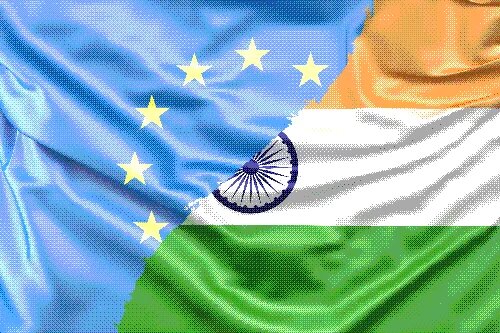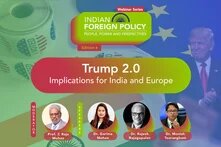Can India protect its development objectives by signing a free trade agreement with an unequal partner with different ambitions?

In the middle of a global geo-political flurry to sign regional or bilateral free trade deals, negotiations on a free trade agreement (FTA) between the European Union (EU) and India have restarted in July 2022. India, in particular, has recently increased the scale of its engagement in FTAs with several developed countries and has responded to EU’s multiple calls to rekindle the moribund FTA after a hiatus of nearly nine years. The fourth round of negotiations was recently concluded in Brussels and the next round is scheduled for 12-16 June. The parties have also embarked on parallel negotiations on an investment protection agreement and on an agreement on Geographical Indications (GIs), both seem to be driven by key interest from the European side.
In spite of the earlier impasse in the FTA negotiations between 2013 and 2022, there seems to be an outward optimism to achieve “economic growth and create employment opportunities” on both sides[i]. However, in an FTA between very unequal partners, this belief needs to be clearly based on factual analysis, especially in respect of India’s development pathways and both parties’ commitments to the Sustainable Development Goals (SDGs). There are also concerns regarding the impact on more vulnerable constituencies such as women, small farmers, workers, patient groups, rural and indigenous populations.
Apart from a geo-political alliance through this FTA in which both parties seem interested, the EU has tabled publicly available proposals[ii] that indicate interests in agricultural products, automobiles, retail, financial and insurance services, investment, and government procurement as well as intellectual property rights provisions related to pharmaceuticals and agriculture. Moreover, the EU has unilaterally added on new chapters such as on digital trade, energy and raw material, sustainable food systems, and state-owned enterprises. India has offensive interests in information technology (IT)-related services, in access for Indian service sector workers, in garments, leather, gems and jewellery, automobile and machine parts, and a few other industrial products. The article takes up some of these critical issues, especially EU demands, from an Indian development perspective[iii].
It is also to be noted that even though the EU has tabled very ambitious demands, its intentions have at least been made clear by the publicly available proposals. India’s specific approach and textual proposals have been relatively closed until now. Globally, trade policymaking has been characterised by a serious deficit in transparent and democratic negotiations. This includes sharing of public information and meaningful participation, especially of economically and politically weaker constituencies. In spite of so-called consultations on both sides, primarily with the private sector, this FTA is no exception.
Agriculture and dairy
Securing ambitious cuts in import duties across all goods sectors, including agriculture and dairy, is one of the EU’s main objectives in this FTA. However, import duties are India’s main tool to protect domestic production and support the livelihoods of millions of farmers and milk producers, the largest percentage of who are extremely small-scale and are focused on domestic markets rather than exports. The EU’s demands will impact both processing sectors in food and dairy, as well as basic agricultural products. The EU’s average most favoured nation (MFN) applied tariff[iv] on agricultural products is 11.7 per cent compared to India’s 39.2 per cent, so India will have to cut tariffs much more than the EU. In addition, the EU will not have to cut its massive agricultural or dairy subsidies amounting to USD 85,909 million in 2018[v], which gives it tremendous price advantage in Indian markets or lower its high food standards, which makes it impossible for Indian farmers to export to the EU.
According to Yudhvir Singh, general secretary, Bhartitya Kisan Union (Tikait), opening up agriculture, dairy and fisheries to the EU under this FTA is of major concern to Indian farmers. “For us, agriculture is our life, our heritage and the source of food and livelihoods. We do not wish to sell in EU markets and cannot meet the EU standards. But heavily subsidised products from the EU will take away our space in our own national market as well”, he said[vi].
In particular, small scale farmers, including millions of women farmers, are likely to be outcompeted by the subsidised agricultural products from the EU. Even if these are in processed segments in both agriculture and dairy, such imports will have the potential to hurt the primary producers who cater to the processing segment. The Indian government seems to share the concerns on market access[vii].
Moreover, the EU’s ambitious demand that India should join the International Convention for the Protection of New Varieties of Plants (UPOV 1991) Treaty, which is essentially designed and promoted by seed-breeding companies, will in effect establish multi-national corporation (MNC) control over seeds thus superseding India’s national laws and farmers’ rights to freely use, save, and exchange seeds and make agrochemicals more expensive[viii]. Moreover, the EU’s push for a separate agreement on GI to ensure European monopolies on certain products will create massive challenges for infant food industries such as dairy, which are just beginning to grow and make new products such as cheese.
Further, the EU has also tabled a chapter on sustainable food systems (SFS) that can create major challenges for Indian farmers. While SFS is a progressive concept advanced even by civil society organisations (CSOs) and progressive policy experts, the EU’s conceptualisation of SFS seems aimed at protecting its agribusiness. For example, the proposed chapter promotes a framework of “economic profitability”, which insists that an enterprise must always be profitable. Using similar arguments, it also pushes for a maximisation of taxes and minimisation of subsidies in agriculture and food sectors. The majority of Indian farmers, mostly small and marginal, are neither profitable nor able to pay taxes. Further, they are heavily dependent on basic subsidies just to survive. Such stipulations through the SFS chapter will protect European food companies over the livelihoods of Indian small farmers. The EU’s framework on SFS is seemingly rooted in SDG2 but while the latter clearly attempts to protect small farmers’ productivity and livelihoods, the EU’s chapter can have the exactly opposite impact.
Access to medicines and EU’s TRIPS Plus demands
There are also major concerns about the impact of the EU’s push for commitments beyond the World Trade Organisation (WTO)’s Agreement on Trade Related Aspects of Intellectual Property Rights (TRIPS) on access to medicines not only in India but across the developing world. Two clauses, namely patent term extension and data exclusivity (DE), will have the effect of delaying the entry of cheaper on generic medicines into the market and prolonging patent monopolies. The EU has demanded patent terms be extended by up to five years (often on multiple patents on the same medicine) and data exclusivity that allows clinical trial data to be protected even when the company has not secured a patent for eight to eleven years. Proposed DE provisions will also force unnecessary and unethical repeat of clinical trials by Indian generic companies even when results from clinical trials of the originator company is already available. It is also to be noted that compulsory licenses[ix] cannot be issued during this period. Finally, the border enforcement measures proposed by the EU extend the ability of a third country to enforce intellectual property (IP) rights even in case of suspected violations of patents. This implies that Indian generic medicines in transit to other countries can be confiscated by the EU Member States on alleged intellectual property violation charges. This had already been a contentious issue between the two partners and was settled at the WTO where the EU had agreed to desist from such actions.
These provisions would severely impact the production of generic medicines in India and compromise access to medicines not only in India but also across the world, with adverse implications for meeting Goal 3 of the SDGs. Among the more vulnerable are women, the poor and rural populations who already have severely constrained access to both medicines and health services. In a press release on 23 March 2022, Medicins Sans Frontieres expressed its concerns about EU’s demands related to IPRS and the impact on access to medicines. It said: “Given the direct impact the EU-India trade deal could have on availability of affordable treatments from India, MSF called on the EC to stand by its earlier commitment to not pursue the issue of supplementary protection any longer in the negotiations and to ensure that the FTA will not require India to introduce any kind of data exclusivity provisions. MSF also called on negotiators to ensure that IP enforcement provisions, including the controversial border measures that can block trade in legitimate generic medicines, be completely removed from the FTA negotiations”[x].
Government Procurement as a development policy tool gets undermined
The EU is also asking India for full liberalisation of the government procurement (GP) market of central and state entities. This could in principle include the railways or even the national public food programme (known as the Public Distribution System). Moreover, GP is a development policy tool used in India to support micro, small and medium enterprises (MSMEs), village enterprises, women entrepreneurs and other backward communities, all of which will be compromised. Even the promotion of local content in GP as a key measure under the Prime Minister’s “Make in India initiative” will be challenged by the EU’s demands. This is again a case where there are clear adverse implications on women. India has special preferential procurement policies for women’s self-help groups (SHGs), for example in the Indian Railways. Such procurement policies above the agreed threshold limits may have to be compromised or extended to EU women entrepreneurs who may be far ahead of Indian women entrepreneurs in economic might. In a rather short-sighted move, India has opened up its GP market to the United Arab Emirates (UAE) under the UAE-India FTA to cater to its own offensive interests. But extending this market to the EU where India has no offensive and only defensive interest will be far more challenging for its development policy pathways.
Digital policy and digital trade demands
Digital trade is a new chapter, which is now an integral part of all EU FTAs but an area on which India has been relatively cautious. This approach has enabled it to secure the policy space to design its National Data Governance Framework, Data Protection Act and to amend the Information Technology Rules 2021. While these rules and laws are far from perfect, these may now be undermined by the EU’s demands to fully liberalise cross-border data flows, which will now allow India to use and develop economic rights around data, liberalise even government data equally for Indian and foreign companies, remove taxes on e-transmissions, and a ban on requiring transfer or access to source code. Such commitments will pre-empt India from designing its own digital economic and industrial policies and grossly violate its own position to not engage in the plurilateral e-commerce initiative at the WTO[xi]. Loss of revenue from a permanent removal of border taxes on e-transmissions as proposed by the EU will also have implications for India. According to a United Nations economist, India lost USD 1.53 billion in revenue in 2020 and USD 4.92 billion between 2017 and 2020 because of the current WTO moratorium on such taxes[xii], which India is looking to terminate.
EU’s quest for raw materials
Under the investment chapter negotiations, the investment protection provisions proposed by the EU are way more ambitious compared to India’s model Bilateral Investment Treaty[xiii] and involves the infamous investor-state-dispute-settlement (ISDS)[xiv] mechanism, which may increase natural resource grab and prevent conservation efforts. In addition, the EU has also proposed a chapter on raw material and energy. The proposed provisions in this chapter such as the prohibition on subsidies to domestic industry or on setting domestic prices of critical energy products will severely undermine India’s policy flexibility to support the production and consumption of its energy products and services, including the development of renewable energy. These two chapters, combined with the EU’s demand to remove all export taxes on exports to the EU will cater to the EU’s quest to secure raw material supplies from developing countries as outlined in its Raw Material Initiative (2008) and the proposed Raw Materials Act[xv]. As a result, India will be unable to shape its future raw material and energy sector policies, and conserve and prevent the outflow of its environmental resources.
Sustainable development must ensure true sustainability
In spite of such demands, the EU claims to promote sustainability standards through various chapters such as SFS, raw material and energy, and an expanded chapter on sustainable development, all of which seem designed to use sustainability standards as a tool to expand market access rather than support India’s efforts towards achieving higher sustainability. The EU’s FTA demands are also at odds with its proclaimed objective of ensuring sustainability globally such as through its Carbon Border Adjustment Measures (CBAMS)[xvi]. Interestingly, the EU does not address substantive issues that have adverse impact on environmental conservation such as the ISDS. Nor does it talk of waiving intellectual property rights to promote transfer of technology in medicines or environmental products, which could go a long way towards making the Indian economy more sustainable. While there is a genuine belief among many that trade agreements can cater to the needs of sustainability and equality, whether such objectives are possible to meet under a harsh commercial framework of trade agreements remains a major question.
Exacerbation of inequality across constituencies
As was mentioned earlier, the proposed FTA raises concerns regarding the impact on vulnerable constituencies. The impact on jobs for workers in the informal industrial segments and services, the loss for small farmers, for poorer patients who will have reduced access to medicines and health services due to higher costs, rural populations who will lose access to natural resources through the investment chapter, and on small businesses who may lose access to critical markets will need to be taken into account. The FTA will also hurt them by constraining their access to natural resources, critical services, medicines, finance and economic opportunities.
The differential impact on women as farmers, workers, entrepreneurs and patients expected from this FTA have already been highlighted. It is interesting that while the EU claims to address gender issues under its sustainable development chapter and offers some regulatory language, it actually fails to address concerns for women that stem from the substantive provisions of the agreement demanded by itself, such as in agriculture, access to medicines and government procurement. Like the issues related to environment mentioned above, this raises a suspicion that sustainable development chapters such as these are popularising tools to get buy-in for the FTA but does not intend any substantive correction of the real adverse impact on vulnerable constituencies.
Interestingly, rising inequality stemming from this FTA is not only expected by CSOs and trade analysts but was projected very clearly in the impact assessments commissioned by the European Commission around 2009 (Ecorys et al)[xvii] and in the recent one conducted by European Parliamentary Research Service (EPRS, 2020)[xviii]. The study by EPRS points out that “the effects of trade liberalisation on poverty and inequality are complex and that the outcome is not unambiguously pro-poor. These effects are indeed context-specific and may impact several dimensions of inequality …. Relatedly, there may be 'adjustment costs' in the absence of policy intervention”.
India’s trade and development policy space
India’s FTAs with developed countries pose a bigger challenge as India will lose rather than gain from import duty cuts, the primary target of FTAs. India’s average MFN applied duties in agricultural and non-agricultural products are 39.2 per cent and 14.9 per cent compared to EU’s 11.7 per cent and 4.1 per cent, implying much higher tariff cuts for India[xix]. At the same time, deepening and expanding scope of such FTAs pose a tremendous threat to national sovereign policy space of all developing country governments. India is engaging in this FTA apparently in the interest of a few manufacturing sectors such as textiles and garments, leather, gems and jewellery, machinery parts, and the IT sector, which is already past its prime. Its demands on migration of workers under Mode 4 has never yielded any positive outcomes and is likely to see even more resistance from developed countries as evident from the UK-India FTA negotiations. However, as a result of this FTA, it will face constraints on its policy space for pursuing its national policies related to agriculture and food, industry, services, health and medicines, natural resource conservation, government procurement as well as its independent digital policy. These will have critical impacts also on India’s ability to meet the SDGs. It’s policy space for social development and for meeting SDGs may also be significantly reduced given the expected loss in tariff revenues. The EPRS (2020) study estimates a tariff revenue loss from the FTA under deep tariff cuts at EUR 0.91 billion for the EU, and a mammoth EUR 1.86 billion for India.
Conclusion
While the EU and India are and will remain major trading partners and key allies on many global issues, the signing of an FTA between two very unequal partners with different ambitions may be counter-productive. Further the EU’s position at the WTO has often undermined India’s development concerns in the areas of agriculture, fisheries, services, investment and special and differential treatment. A better harmonisation on WTO positions is necessary before an ambitious agreement between the two sides can be effective. Given the major gaps and concerns related to this FTA, both sides may be able to achieve far more by strengthening their existing cooperation agreement of 1994.
Endnotes
[iii] For a more detailed analysis covering these and several other issues such as services, manufacturing, migration, etc. read Ranja Sengupta (2023), “Development Opportunities or Challenges: Looking at the Free Trade Agreement between India and the European Union”, February 9th, Rosa Luxemburg Stiftung, https://www.rosalux.eu/en/article/2207.development-opportunities-or-challenges.html
[iv] The most favoured nation or MFN tariff is the actual applied tariff imposed by a country that is applicable to all WTO Member Countries. FTAs can negotiate preferential applied tariff rates.
[v] Sum of Current Total Aggregate Measurement of Support (CTAMS) and Green Box (GB) subsidies.
[vi] Press Release by Forum for Trade Justice India, “EU India Free Trade Deal will Undermine India’s Development“, 9 December 2022, https://focusweb.org/eu-india-free-trade-deal-will-undermine-indias-dev…
[viii] Press Release by Forum for Trade Justice India, 9 December 2022
[ix] Under the flexibilities allowed by the TRIPS Agreement, a government can issue a compulsory license to a generic company to produce a patented medicine without the consent of the patent owner (or itself produce) under certain conditions.
[x] MSF Press Release, “EU-India FTA negotiations could have negative impact on access to medicines”,
14 March 2023, https://msfaccess.org/news-update-eu-india-fta-negotiations-could-have-…
[xi] For an analysis of the challenges this initiative may create for developing countries read,https://unctad.org/publication/joint-statement-initiative-e-commerce-ec…
[xii] Rashmi Banga (2022): “WTO Moratorium on Customs Duties on Electronic Transmissions: How much tariff revenue have developing countries lost?”, Research Paper No.157, South Centre, 3rd June, https://www.southcentre.int/wp-content/uploads/2022/06/RP157_WTO-Morato…
[xiii] See India’s model text to reform its BITS at https://www.mygov.in/sites/default/files/master_image/Model%20Text%20fo…
[xiv] The ISDS mechanism allows foreign investors to sue national governments even for critical policy changes in secret international arbitration cases.
[xvi] For an interesting article explaining the conflict between the EU’s FTA approach and on CBAMS, read Sangeeta Godbole (2023): “Inconsistent green energy stances by EU – CBAM versus FTA”, TWN Info Service on Climate Change, 20th May 2023, https://twn.my/title2/climate/info.service/2023/cc230504.htm
[xvii] Ecorys et al. (2009): “Trade Sustainability Impact Assessment for the FTA between the EU and the Republic of India”, commissioned by the European Commission DG-Trade
[xviii] EPRS (2020): “Assessing the potential impact of an EU-India trade agreement: Cost of Non-Europe Report”, https://www.europarl.europa.eu/RegData/etudes/STUD/2020/642841/EPRS_STU…. Similar apprehensions were also expressed in earlier impact assessment studies.
[xix] Moreover, 28.6 per cen and 34.6 per cent of EU non-agricultural imports already enter duty-free or at less than 5 per cent import duty, respectively.


